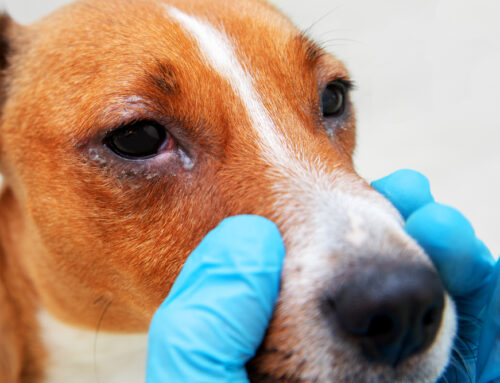Seeing your pet’s eyes turn yellow can be alarming. This yellowing, called jaundice or icterus, occurs from excess bilirubin, a pigment associated with the oxygen-carrying molecule in red blood cells. Bilirubin that builds up in the blood can accumulate in tissues and appear as yellow discoloration in the whites of the eyes, skin, and mucous membranes. The Veterinary Vision Center team shares what pet owners need to know about yellow eyes in pets.
What is jaundice in pets?
Jaundice is not a disease in itself. Rather, the yellow color indicates an underlying issue with bilirubin production, breakdown, or clearance from the body. Under normal circumstances, bilirubin is released from red blood cells, processed by the liver, and excreted through the intestines. Any disruption in this process, including too much bilirubin production from excess red blood cell breakdown or reduced clearance from a liver disorder, can result in jaundice.
What causes jaundice in pets?
Jaundice has many possible causes in dogs and cats, and all require prompt veterinary attention for diagnosis and treatment. Problems with the immune system, liver, spleen, or gallbladder can result in jaundice. Common causes include:
- Liver disease — A damaged or diseased liver cannot process bilirubin efficiently, which can lead to buildup in the bloodstream. Possible dysfunctions include inflammatory or autoimmune hepatitis, cirrhosis, liver tumors, copper storage disease, and toxin or drug damage.
- Hemolytic anemia — This condition occurs most often from the autoimmune destruction of red blood cells (i.e., immune-mediated hemolytic anemia [IMHA]), which releases large amounts of bilirubin. Other causes include blood parasites or toxins.
- Bile duct obstruction — An obstructed bile duct prevents the transport of bile from the liver to the gallbladder and intestines, leading to jaundice. Common causes include gallstones, tumors, infections, and pancreatitis.
- Infectious disease — Infectious diseases that target the liver or red blood cells may lead to jaundice. Examples include feline infectious peritonitis (FIP), canine adenovirus, and leptospirosis.
Recognizing jaundice in pets
Pets with jaundice may develop not only yellow eyes, but also yellow skin and gums, dark yellow urine, lethargy, appetite loss, vomiting, diarrhea, or abdominal pain or swelling. The symptoms vary depending on the underlying condition and may help veterinarians diagnose the problem. Seek your primary veterinarian’s care or visit a veterinary emergency center if your pet is turning yellow, as prompt evaluation is critical for your pet’s long-term health. If we see that your pet’s eyes are yellow during an ocular examination, we will work with your primary veterinarian to coordinate the appropriate tests and care.
Not all yellow eye coloration in pets can be attributed to jaundice. Inflammation inside the eye, or uveitis, can sometimes cause the iris—the colored eye portion surrounding the pupil—to swell or become infiltrated with abnormal blood vessels. Depending on the color of your pet’s iris, this inflammation can cause a yellow or amber appearance. If your pet’s iris color changes, a prompt visit with our ophthalmology team is warranted.
Diagnosing and treating jaundice in pets
Diagnosing the underlying cause of jaundice requires a thorough physical examination and multiple diagnostic tests, including specialized blood tests, urinalysis, X-rays, ultrasound, and possible advanced imaging or liver biopsy. Treatment is aimed at the underlying cause and may include antibiotics, immunosuppressive medications, liver support supplements, blood transfusions, emergency surgery, specialized diets, and hospitalization for supportive care.
Jaundice in your dog or cat signifies that they need veterinary attention. The underlying causes of jaundice are serious, but timely recognition and treatment can help ensure the best possible outcome for your pet. If your pet’s skin or eyes appear yellow, seek immediate care with your primary veterinarian or local emergency hospital. For other eye color changes, schedule a visit with our Veterinary Vision Center team.







Leave A Comment